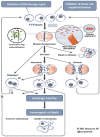Tumor-Treating Fields Therapy for Pediatric Brain Tumors
- PMID: 33917660
- PMCID: PMC8167650
- DOI: 10.3390/neurolint13020015
Tumor-Treating Fields Therapy for Pediatric Brain Tumors
Abstract
Tumor-treating fields (TTFields) are alternating electric fields applied continuously to the brain by attaching two-pair arrays on the scalp. Although TTFields therapy has demonstrated efficacy against supratentorial glioblastoma (GBM) in adults, its safety and efficacy in children have not been confirmed. Despite differences in the genetic etiology of the adult and pediatric forms of GBM, both have certain clinical behaviors in common, allowing us to test TTFields therapy in pediatric GBM. Recently, several, pediatric case-series using TTFields therapy have been published, and a few, prospective, pediatric studies are ongoing. Because GBMs are extremely rare in pediatric patients, where they comprise a wide variety of genetic subtypes, these pediatric studies are feasibility studies targeting various types of malignant brain tumor. Although they are important for confirming the safety and feasibility of TTFields therapy in the pediatric population, confirming its efficacy against each type of pediatric brain tumor, including the GBM, is difficult. Our clinical research team, therefore, planned an investigator-initiated clinical trial targeting pediatric supratentorial GBMs (as in adults) with the aim of expanding regulatory approval of TTFields therapy for pediatric GBM treatment based on safety and exploratory efficacy data in combination with the accumulated evidence on adult GBMs.
Keywords: TTFields; clinical trial; glioblastoma; pediatric brain tumors; tumor-treating fields.
Conflict of interest statement
Nishikawa (R.N.) reports receiving advisory board fees from Novocure, Ltd. The other authors declare no conflicts of interest.
Figures


References
-
- Stupp R., Hegi M.E., Mason W.P., van den Bent M.J., Taphoorn M.J., Janzer R.C., Ludwin S.K., Allgeier A., Fisher B., Belanger K., et al. European Organisation for Research and Treatment of Cancer Brain Tumour and Radiation Oncology Groups; National Cancer Institute of Canada Clinical Trials Group. Effects of radiotherapy with concomitant and adjuvant temozolomide versus radiotherapy alone on survival in glioblastoma in a randomised phase III study: 5-year analysis of the EORTC-NCIC trial. Lancet Oncol. 2009;10:459–466. - PubMed
-
- Stupp R., Taillibert S., Kanner A., Read W., Steinberg D., Lhermitte B., Toms S., Idbaih A., Ahluwalia M.S., Fink K., et al. Effect of tumor-treating fields plus maintenance temozolomide vs maintenance temozolomide alone on survival in patients with glioblastoma: A randomized clinical trial. JAMA. 2017;318:2306–2316. doi: 10.1001/jama.2017.18718. - DOI - PMC - PubMed
-
- Cohen K.J., Pollack I.F., Zhou T., Buxton A., Holmes E.J., Burger P.C., Brat D.J., Rosenblum M.K., Hamilton R.L., Lavey R.S., et al. Temozolomide in the treatment of high-grade gliomas in children: A report from the Children’s Oncology Group. Neuro Oncol. 2011;13:317–323. doi: 10.1093/neuonc/noq191. - DOI - PMC - PubMed
Publication types
Grants and funding
LinkOut - more resources
Full Text Sources
Other Literature Sources

